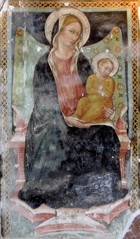Bartolomeo da Miranda came from the fortified village of Miranda, some 10 km south east of Terni. He was documented in Todi in 1437, when Bishop Bartolomeo Aglioni asked him to evaluate a work of art that he had commissioned from Lello da Velletri. This was an important commission, and Bartolomeo must have been at the height of his career. He is referred to in this document as “Bartholomeum magistri Dominici de Miranda habitorem in civtate Spoleti” (Bartolomeo, the son of Domenico da Miranda, a citizen of Spoleto).
His father, Domenico da Mirando, was documented among the artists at work in the Vatican for Pope Urban V in 1369. He was subsequently documented at Spoleto, where he produced a miniature for the Duomo in 1395 and where he worked for the Commune in 1404. No surviving works of art can be attributed securely to him, but Filippo Todini (1991) suggested he could be the Maestro della Dormitio di Terni. Domenico may well have moved his family to Spoleto in or before 1395, either before Bartolomeo was born or while he was still very young.
The surviving works signed by Bartolomeo are:
-
✴a fresco (1449) of the Madonna del Latte with SS Catherine of Alexandria, Mary Magdalen, John the Baptist and Bernardino of Siena in SS Pietro e Andrea, Trequanda (40 km south east of Siena); and
-
✴a number in Santa Maria di Pietrarossa, outside Trevi (see below), one of which is dated by inscription to 1449.
Most of the attributions below are by Bruno Toscano (1984).
Spoleto
Madonna and Child (1437)
Sant’ Eufemia Tryptych (1450)
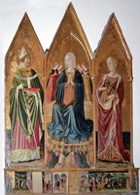
The altarpiece is usually attributed to Bartolomeo da Miranda, although Filippo Todini has rejected this and designated it as the autograph work of the Maestro del Trittico di Sant’ Eufemia. It altarpiece depicts:
-
✴the Virgin of the Assumption, with four angels and the Apostles in the central panel;
-
✴St John of Spoleto (whose relics were under the altar) on the left; and
-
✴St Lucy on the right.
The predella depicts three scenes the martyrdom of St Lucy.
Communion of St Catherine of Siena (ca. 1461)
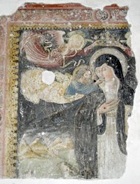
Bevagna
Annunciation (15th century)

Massa Martana
Madonna del Latte with Saints (15th century)
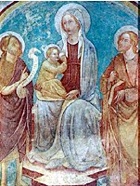
Montefalco
Frescoes (15th century)

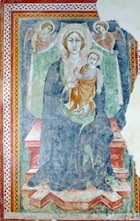

Three frescoes on the right wall of Santa Maria di Turrita are attributed to Bartolomeo da Miranda:
-
✴St Christopher, who carries the baby Jesus across a stream;
-
✴the Madonna and Child, with an inscription that includes part of the date (MCCCC...); and
-
✴the Madonna and Child with St Lucy.
Orvieto
Triptych (15th century)
This triptych, which originally belonged to the Confraternita di San Michele Arcangelo, was later in Palazzo Vescovile before it entered the Museo dell’ Opera del Duomo. The central panel depicts a half-length Madonna and Child on a gold background: the baby Jesus holds an apple and points to it with His other hand.
The saints on the inner surfaces of the closing doors were painted over in the 17th century with images of two Servite friars.
Spello
Mystic marriage of St Catherine of Alexandria (1435)

Frescoes (15th century)
These fresco in the Oratorio di San Biagio depict;
-
✴the Madonna and Child with St Peter Martyr and St Blaise, in which St Blaise holds the wool comb with which his flesh was torn to shreds during his martyrdom (on the back wall, to the left); and
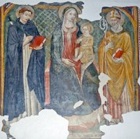
-
✴St Antony of Padua (on the right wall).
Madonna del Latte (1373, repainted in the 15th century)
The venerated image for which the church was built is on the high altar of the Chiesa Tonda. The 15th century repainting is attributed, somewhat uncertainly, to Bartolomeo da Miranda.
Terni
Madonna and Child (15th century)
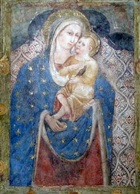
The standing Virgin holds a pomegranate and the baby Jesus points to a bird that He perches on His other arm.
Trevi
As noted above, six frescoes in the church of Santa Maria di Pietrarossa, outside Trevi are signed or attributer to Bartolomeo di Miranda. A number of other frescoes in rural churches in the area are attributed to him.
Santa Maria di Pietrarossa
The frescoes in Santa Maria di Pietrarossa that are (or were) signed by Bartolomeo da Miranda comprise:
-
✴three on the right of the portico:
-
•the Madonna delle Spighe (1449), which depicts the Madonna and Child enthroned, with the Virgin holding a bird and some ears of corn (“spighe”) - illustrated here;
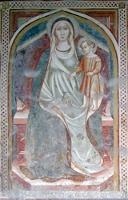
-
•the Madonna with a fragmentary inscription “meo” and another that identifies the donor, Gacucius da Macino;
-
•the Madonna and Child enthroned, with a now illegible inscription, in which the Madonna holds a pomegranate; and
-
✴three on the right wall:
-
•the Annunciation; and
-
•two of the three frescoes of the Madonna and Child below it:
-
-the Madonna and Child enthroned (in the middle); and
-
-the Madonna and Child in which the baby Jesus holds an apple (on the right).
A number of other frescoes in the church are attributed to him.
Other Rural Churches
St Peter
This fresco of the standing St Peter is in the apse of San Pietro a Pettine.
Madonna and Child with angels
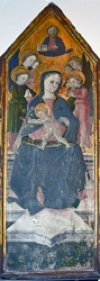
The panel depicts the Madonna and Child with angels. Christ above holds a book with the words (translated) “I am the light of the world”.
Madonna and Child with saints
This fresco, which was discovered in a farmhouse of the Agriturismo i Mandorli, Bovara (which must once have been a chapel) after the 1997 earthquake. It depicts the Madonna and Child with SS John the Baptist and Peter and is dated by inscription to 1449 (or perhaps 1440).
References:
B. Toscano, “Bartolomeo da Miranda”, in M. Natale, “Scritti di Storia dell' Arte in Onore di Federico Zeri”, Milan (1984) Volume I, pp. 93-112.
F. Todini, “Lello da Velletri e il Vero Bartolomeo da Miranda”, Studi di Storia dell’ Arte, 2 (1991) pp. 51-84.
R. Quirino, “La Chiesa di Santa Maria di Pietrarossa presso Trevi: Gli Affreschi”, Bollettino della Deputazione di Storia Patria per l’ Umbria, 87 (1990) 93-103 for the work of Bartolomeo da Miranda in Santa Maria di Pietrarossa.
A. Marbottini Marabotti, “Pinacoteca Comunale di Spello”, Perugia, (1995): p26 for Bartolomeo da Miranda in Spello.
There is a bibliography on this artist on the website Arte Antica.
Return to Art in: Bevagna Massa Martana Montefalco Orvieto


